![]()
![]()
![]()
Use LEFT and RIGHT arrow keys to navigate between flashcards;
Use UP and DOWN arrow keys to flip the card;
H to show hint;
A reads text to speech;
63 Cards in this Set
- Front
- Back
- 3rd side (hint)
|
Policy objective |
A target of a good that a government wishes to achieve |
|
|
|
Economics Objectives |
Economic growth Price stability Minimising unemployment Stable Balance of Payments on the current account |
|
|
|
Economic Growth as EO |
- Wants GDP to steadily rise -GDP= indicator -Improve standard of living + levels of economic welfare |
|
|
|
Minimising unemployment as EO |
Indicator = unemployment rate - create and maintain full employment |
|
|
|
Stable Balance of Payments on the current account as EO |
-trading goods and services -import/ export balance --> small surplus -attain a satisfactory balance of payments usually defined as the avoidance of an external deficit which might create an exchange rate crisis |
|
|
|
Gross Domestic Product (GDP) |
The sum of all goods and services or level of output produced in the economy over a period of time eg a quarter or a year also cab be called national income |
|
|
|
Importance of economic growth |
-shapes government policy -Every time money is spent in the economy it contributed to GDP -Gov/ businesses can plan better -quantity and quality of goods and services up -keep with population growth -allows us to maintain and improved standards of living -increase employment creating jobs -international competitiveness up |
|
|
|
Real vs nominal |
Real= adjusted for inflation Nominal= money terms, which has not been adjusted for inflation |
|
|
|
Real GDP |
A measure of a the goods and services produced in an economy adjusted for inflation. The adjustment transforms changes in nominal GDP, which is measure in money terms into a measure that reflects changes in the total output of economy |
|
|
|
Nominal GDP |
GDP measured at the current market prices without removing the effects of inflation |
|
|
|
Economic growth is usually measured by the annual changed in the retail price index |
Ff |
|
|
|
Short Run (SR) Economic Growth |
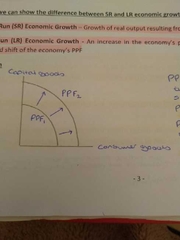
Growth of real output resulting from using idle resources |
|
|
|
Long Run (LR) Economic Growth |
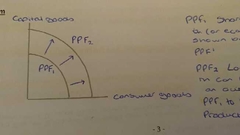
An increase in the economy potential level of real output and an outwards shift of the economy PPF |
|
|
|
Inflation |
Is a persistent or continuing rise in the average price level
Changes in the rate of inflation are caused by the changes in the price of goods and services |
|
|
|
Price level |
Is the average price of goods and services in an economy |
|
|
|
Inflation occurs when most prices are rising by some degree across the whole economy |
Prices rise and fall all the time reflecting customers choices and preferences. If an item become more expensive because of high demand this is not inflation |
|
|
|
Consumer Price Index (CPI) |
The official measure used to calculate the rate of consumer price inflation in UK. The CPI calculated the average price increase of a basket of 700 different consumer goods and services. Currently CPI is used for the indexation of state pensions and welfare benefits and for setting the monetary policy target |
|
|
|
Indexation |
The automatic adjustment of items such as pensions and welfare benefits to changes in the price level, through the use of a index price
-CPI is used for international comparisons -CPI tends to be lower than RPI Can impact people long term of their state benefits and pensions are going up by CPI
|
|
|
|
Retail Price Index (RPI) |
The RPI is an older measure used to calculate the rate of consumer price inflation in the UK. RPI is used each year for updating the cost of TV and motor vehicle licenses, together sometimes with taxes on goods such as alcoholic drinks |
|
|
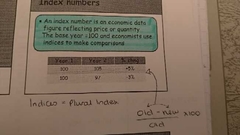
An index number showing the extent to which a price or a basket of "prices" has changed a mmonth quarter, or year in comparison with the price (s) in a base year |
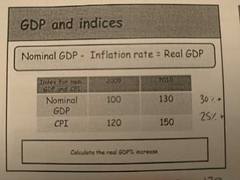
Index number: a number used in an index, such as the CPI to enable accurate comparisons over time to be made CPI IS A WEIGHTED INDEX |
|
|
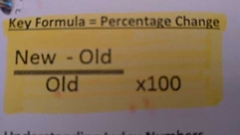
|
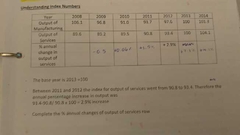
An index number showing |
|
|
|
Price Index construction |
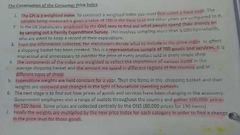
|
|
|
|
Example of price index |
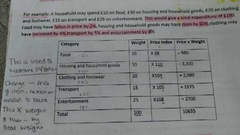
-the price index this year: the sum (price x weight)/ sum of weights (106.35) - the rate of inflation is the % change in the price index from one year to another - if a year later the price index has risen to 122.5 then the annual rate of inflation = (112.5 - 106.35)/ 106.35 x 100. Thus the rate of inflation= 5.78% Measure change in inflation: (New inflation- old inflation) =price index / old inflation x 100 = rate of inflation |
|
|
|
Price index example question |
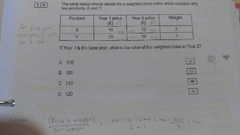
|
|
|
|
Full employment |
According to William Beveridges definition, means 3% or less of the labour force unemployed |
|
|
|
Claimant count |
The method of measuring unemployment according to those people who are claiming unemployment related benefits (JSA) |
|
|
|
Labour Force Survey |
A quarterly sample survey of households in the UK. Its purpose is to provide information on the UK labour markets. The survey seeks information on respondents personal circumstances whether labour market status during a period of 1-4 weeks Primary info used for u/e rate?? |
|
|
|
Balance of payments |
A record of all the currency flows into and out of a country in particular time period |
|
|
|
Current account of the balance of payments |
A record of all the currency flows into and out of a country in particular time period for exports and imports, together income and transfer flows ( primary income and secondary income flows) sections - trade in goods - trade in services -primary income - secondary income |
|
|
|
Difference between exports and imports |
Primary income: Net investment income ( main component) income from assets owned abroad - income received by overseas multi national companies from assets owned in the UK. Other components: - secondary income: current transfers Government payments, aid grants and remittances gifts |
|
|
|
Current account equilibrium |
Occurs when the current account more or less balances over a period of years |
|
|
|
Current account deficit |
Occurs when the currency outflows in the current account exceed currency inflows |
|
|
|
Current account surplus |
Occurs when currency inflows in the current account exceed currency inflows |
|
|
|
Balance of trade |
The difference between a money value of a countries impress of goods and services and its exports Balance of trade is the largest components of a country's current account |
|
|
|
Balance of trade deficit |
The money value of a countries imports exceeds the money value of its exports |
|
|
|
Balance of trade surplus |
The money value of a countries exports exceeds the money value of its imports |
|
|
|
Nominal gdp - inflation rate= real gdp growth |
Gg |
|
|
|
Circular flow of income |
National income = national output = national product (NY=NQ=NI)
ALL MEASURE FLOW IF NEW OUTPUT |
|
|
|
Closed circular flow of income |
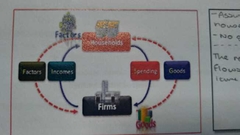
Assumes 2 economic agents: Households and firms No goverment
----- = real flows
The real flows generate money is a of income and expenditure (solid line) |
|
|
|
Income is a FLOW generates over a period of time |
Rds |
|
|
|
Wealth is the STOCK or ASSETS OR things that have value which people own |
Yy |
we |
|
|
Saving |
Income which is not spent |
|
|
|
Withdrawal |
A league of spending power of the circular flow of income into savings, taxation or imports |
|
|
|
Investment |
Total planned spending by firms in capital goods produced within an economy |
|
|
|
Injections |
Spending entering the circular flow of income as a result of government spending, investment and exports |
|
|
|
Consumption |
Total planned spending by house holds on consumer goods and services produced within the economy |
|
|
|
GDP VS GNI |
Both reflect the national output and income of economy
GDP is the flow of output domestically WITHIN the economy
GNI takes into account British residents and companies receiving income from assets they own in other countries, as Well as income produced in the UK flowing out of the country to overseas owners of assets within the UK |
|
|
|
Nominal GDP= real GDP x average current price level for the year |
Hb |
|
|
|
National income |
Measure stage income received by labour and other factors of production when producing the goods and services |
|
|
|
National output |
Measures the acc goods and services produced by the economy |
|
|
|
National expenditure |
Shows the spending of these incomes on goods and services |
|
|
|
Imports |
Bringing goods or services into a country from abroad sale |
|
|
|
Exports |
Sending goods or services into another country for sale |
|
|
|
Circular flow of income: Realistic economy including govt sector |
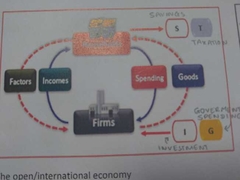
Shows households saving and consuming Shows firms investing capital goods Households save, spending income Investment spending on machinery capital goods is an injection of demand into the economy |
|
|
|
Circular flow of income: open/ international economy |
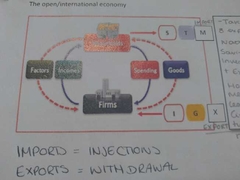
Takes into account imports and exports S+T+M>I+G+X (injections< withdrawals) means net withdrawal or leakage of demand out of the circular flow occurs causing the equilibrium level of national income to fall S+T+M<I+G+X (injections> withdrawals) Means a net injection of demand into the circular flow occurs which causes the equilibrium level of national income to rise |
|
|
|
Equilibrium national income |
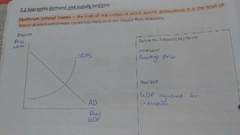
|
|
|
|
Aggregated demand |
The total planned spending on real output produced within an economy |
|
|
|
Aggregate supply |
The level of real output that officers are prepared to supply at different average price levels |
|
|
|
AD |
Total planned spending on RNO produced in the economy C + I + G + ( X - M) |
|
|
|
Household spending as AD |
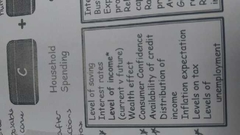
|
|
|
|
Y = income Yd = disposable income |
Income after all deductions - income tax |
|
|
|
Investment as AD |

Shirt term shift AD Long term affects AS |
|
|
|
Government spending |
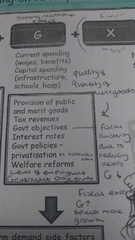
Shirt term shift AD Long term effect AS |
|

